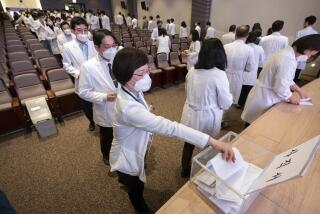Doctors-in-Training: Our Last Indentured Servants
- Share via
NEW YORK — At the outset of the 21st century, the nation’s medical establishment is under siege, pummeled from all directions by cost-conscious bureaucrats, dissatisfied patients and the colossus known as managed care. Now, the profession has yet another interloper encroaching on its terrain. In a dramatic turnaround, the National Labor Relations Board recently overturned an earlier ruling that prevented American doctors-in-training from joining labor unions. The original ruling, handed down in 1976, officially classified medical residents as students rather than as employees, thereby preventing them from organizing themselves to obtain better working conditions. The new ruling reverses this decision and paves the way for the widespread unionization of both interns and residents. This could represent a substantial threat to the nation’s 400 teaching hospitals, since it gives young doctors a potent new weapon in the fight to improve their dismal working conditions.
As the junior members of the medical hierarchy, residents typically work longer hours than any other professionals on the planet. In seven days, they are expected to cram in as much as 100 hours of work, and a single shift can last as long as the average mortal’s entire workweek. Of course, some in the profession might object to being classified as mere mortals.
The Assn. of American Medical Colleges, which opposed the NLRB decision, worries that the threat of strikes or binding arbitration will undermine the educational mission of hospitals. Jordan J. Cohen, the AAMC president, called such binding arbitration an “abhorrent idea” that would violate the trust that must exist between student and teacher. But for critics of the system, it is hard to see how that trust is enhanced by forcing young doctors to work interminable hours--up to 36 hours at a stretch. Cohen argues that the educational aspects of physician training should take precedence over other issues, and that unionization or collective bargaining threaten the ideals of a medical education.
But a growing body of evidence suggests that the education of residents is suffering because of the extraordinary stress of medical training. In fact, multiple studies have shown that learning may be adversely affected by the severe sleep deprivation endured by thousands of doctors-in-training. In a 1996 report, researchers concluded that learning and memory can be impaired by sleep loss that occurs several days after new tasks have been learned. The Canadian Medical Assn. Journal reported that this could have significant implications for individuals whose work requires continual learning as well as high standards of performance. Medical residents certainly fit these criteria.
Though further research is needed to clarify the matter, other studies have shown a similar pattern. A 1996 review in the journal Sleep that examined 19 research projects found that sleep deprivation strongly impairs human function. It also found that the effects of sleep deprivation may actually be underestimated. This may explain a curious anomaly seen in a number of surgical investigations: According to the Journal of Occupational and Environmental Medicine, studies of surgical residents frequently show that sleep deprivation has little impact on performance, in contrast to studies conducted by other medical specialties. In one study conducted by surgeons at the Medical College of Wisconsin, for example, sleep loss had no apparent effect on cognitive performance. The reasons for this discrepancy are unclear, but surgical programs stand out in other respects as well. According to the Journal of the American Medical Assn., surgery training programs consistently demand more time and effort from their residents than virtually any other specialty. In a national survey, surgical residents reported the most hours on call, while surgical and obstetric residents reported the highest levels of sexual harassment, discrimination and other types of mistreatment during their training.
This suggests a possible connection, in which the specialty reporting the highest level of resident abuse also tends to minimize the impact of sleep deprivation. Although this might be a coincidence, it merits closer examination. Could a surgical culture wedded to intensive training be affecting the results of its own performance studies?
At least one report, published in 1989, has examined possible bias in the medical community. It concluded that members of the medical hierarchy are likely to minimize the prevalence of serious distress among residents. Tellingly, it also noted that the degree to which the prevalence is underestimated increases as one moves up the hierarchy.
Potentially abusive practices occur in other specialties too. The JAMA survey indicated that 93% of doctors-in-training experienced at least one incident of harassment or verbal abuse and more than half reported episodes of being belittled or humiliated by more senior physicians. Perhaps even more important, 70% of the residents reported seeing colleagues working in an impaired condition, most often due to a lack of sleep. In addition, the survey documented a pattern of mistreatment that closely paralleled similar reports of abuse by American medical students.
The data provide further evidence of a psychological divide between the teachers and students in the U.S. medical system. It also underscores the essence of the residency debate, which is really a power struggle between the medical establishment--holding enormous sway over doctors-in-training--and the young doctors themselves.
With the NLRB’s groundbreaking decision, however, the balance of power has suddenly shifted. Through collective action, residents may now have the leverage to improve conditions for themselves and their patients. This could lead to new reforms in the medical system, such as enforceable limits on the length of individual shifts and strict guidelines regarding sleep deprivation. These reforms could follow the model of programs that already have sought to improve residency working conditions. A Veterans Affairs Medical Center study, for instance, specifically examined the impact of residency work schedules on patient care. It found that changing work schedules to reduce sleep deprivation yielded two key benefits for hospitalized patients: shorter stays and fewer medication errors. Better-rested residents committed 29% fewer errors than residents following a traditional overnight-call schedule.
Though reducing the number of hours worked will mean increased costs for teaching hospitals, some of these costs may be recouped through more efficient patient care, such as the shorter hospitalizations and decreased use of health care resources shown in the VA study. The question is, does the medical establishment have the will to change? Can it stop compelling young doctors to forgo the most basic human needs as the price of admission into the healing profession? One thing is certain: It will have to wean itself from antiquated traditions and financial imperatives, since academic institutions rely on residents as an abundant source of cheap labor. This has made them a highly valuable commodity. Unfortunately, it has also given them the distinction of being among the last indentured servants of the modern age.
More to Read
Sign up for Essential California
The most important California stories and recommendations in your inbox every morning.
You may occasionally receive promotional content from the Los Angeles Times.










